traction control BMW X5 2002 E53 DSC System Workshop Manual
[x] Cancel search | Manufacturer: BMW, Model Year: 2002, Model line: X5, Model: BMW X5 2002 E53Pages: 24, PDF Size: 1.77 MB
Page 2 of 24
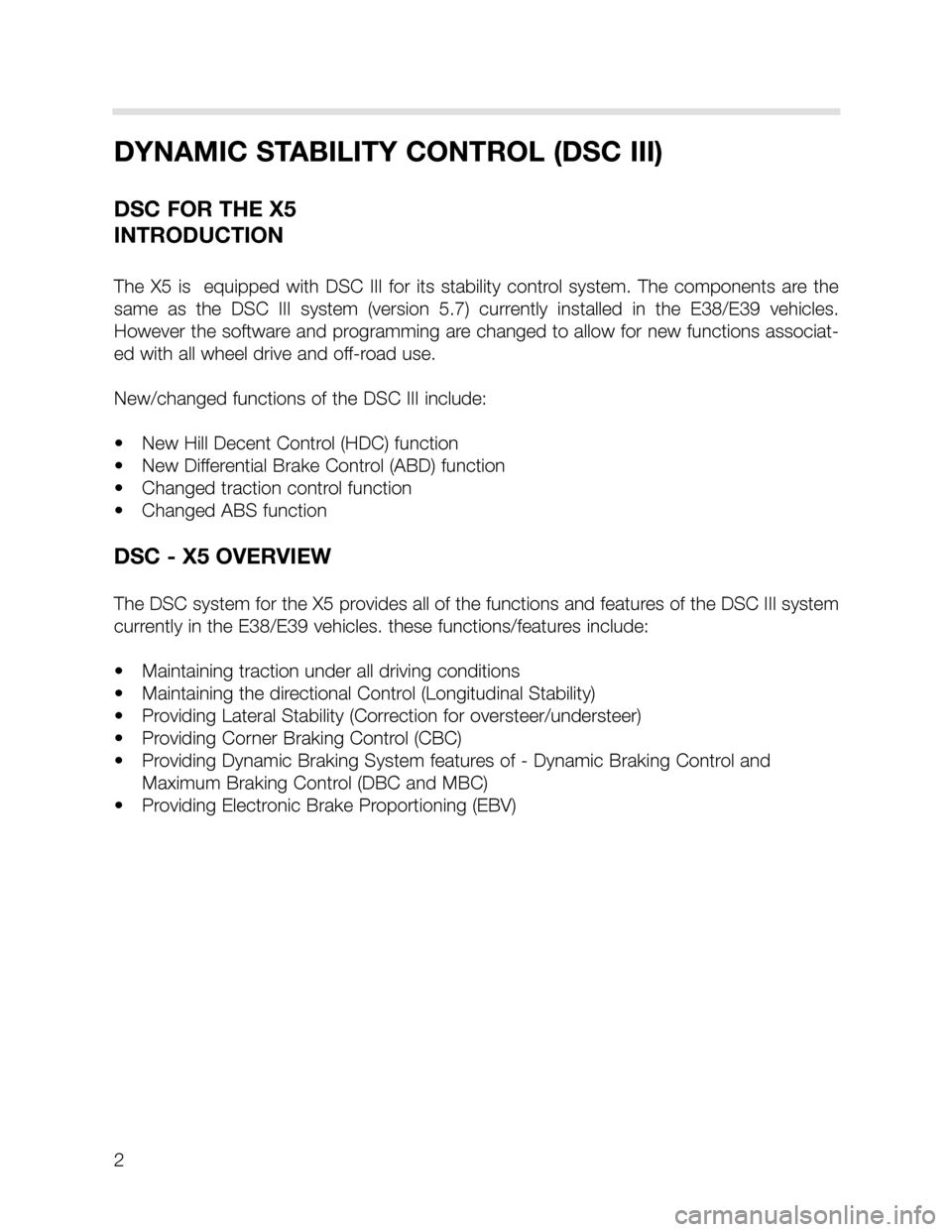
2
DYNAMIC STABILITY CONTROL (DSC III)
DSC FOR THE X5
INTRODUCTION
The X5 is equipped with DSC III for its stability control system. The components are the
same as the DSC III system (version 5.7) currently installed in the E38/E39 vehicles.
However the software and programming are changed to allow for new functions associat-
ed with all wheel drive and off-road use.
New/changed functions of the DSC III include:
• New Hill Decent Control (HDC) function
• New Differential Brake Control (ABD) function
• Changed traction control function
• Changed ABS function
DSC - X5 OVERVIEW
The DSC system for the X5 provides all of the functions and features of the DSC III system
currently in the E38/E39 vehicles. these functions/features include:
• Maintaining traction under all driving conditions
• Maintaining the directional Control (Longitudinal Stability)
• Providing Lateral Stability (Correction for oversteer/understeer)
• Providing Corner Braking Control (CBC)
• Providing Dynamic Braking System features of - Dynamic Braking Control and
Maximum Braking Control (DBC and MBC)
• Providing Electronic Brake Proportioning (EBV)
Page 3 of 24
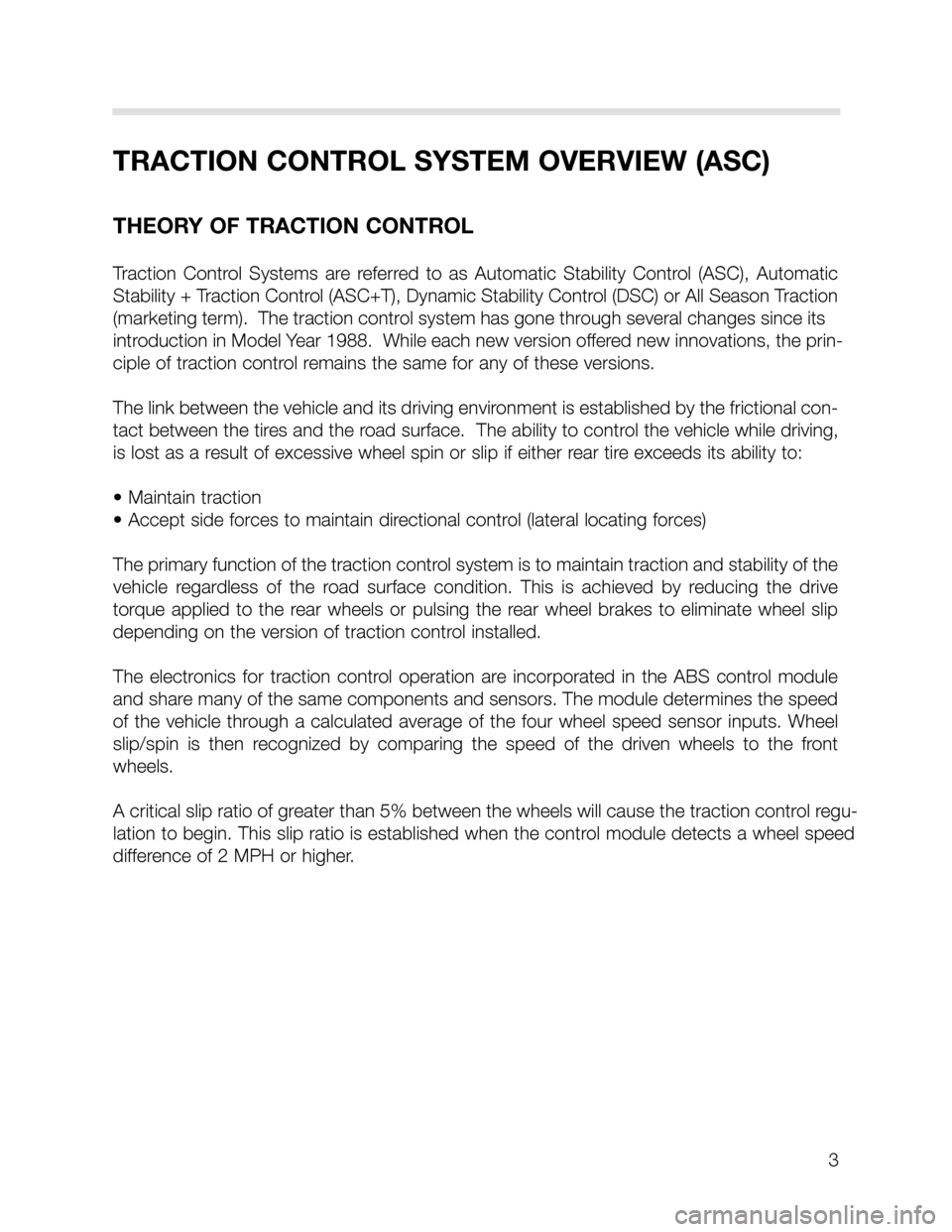
3
TRACTION CONTROL SYSTEM OVERVIEW (ASC)
THEORY OF TRACTION CONTROL
Traction Control Systems are referred to as Automatic Stability Control (ASC), Automatic
Stability + Traction Control (ASC+T), Dynamic Stability Control (DSC) or All Season Traction
(marketing term). The traction control system has gone through several changes since its
introduction in Model Year 1988. While each new version offered new innovations, the prin-
ciple of traction control remains the same for any of these versions.
The link between the vehicle and its driving environment is established by the frictional con-
tact between the tires and the road surface. The ability to control the vehicle while driving,
is lost as a result of excessive wheel spin or slip if either rear tire exceeds its ability to:
• Maintain traction
• Accept side forces to maintain directional control (lateral locating forces)
The primary function of the traction control system is to maintain traction and stability of the
vehicle regardless of the road surface condition. This is achieved by reducing the drive
torque applied to the rear wheels or pulsing the rear wheel brakes to eliminate wheel slip
depending on the version of traction control installed.
The electronics for traction control operation are incorporated in the ABS control module
and share many of the same components and sensors. The module determines the speed
of the vehicle through a calculated average of the four wheel speed sensor inputs. Wheel
slip/spin is then recognized by comparing the speed of the driven wheels to the front
wheels.
A critical slip ratio of greater than 5% between the wheels will cause the traction control regu-
lation to begin. This slip ratio is established when the control module detects a wheel speed
difference of 2 MPH or higher.
Page 4 of 24
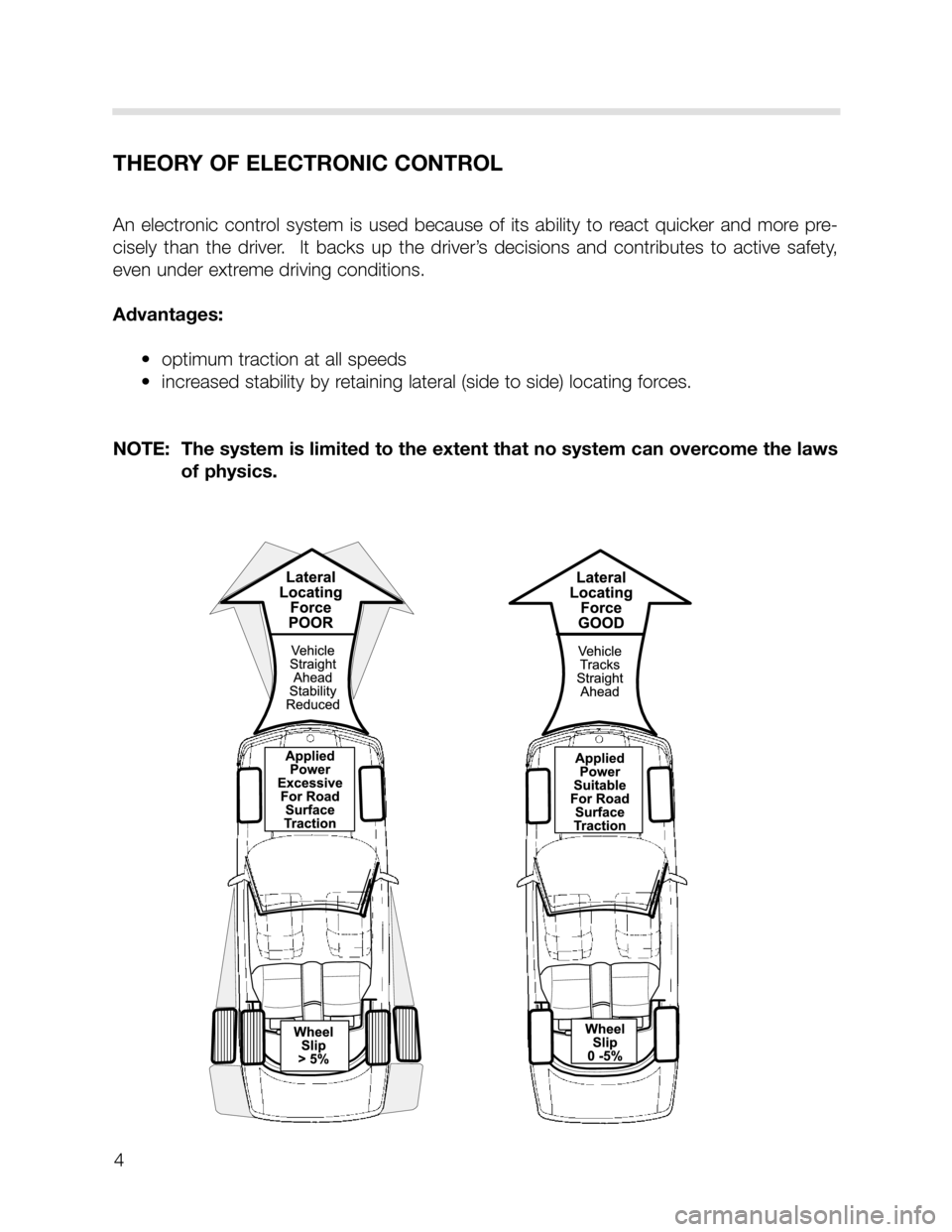
4
THEORY OF ELECTRONIC CONTROL
An electronic control system is used because of its ability to react quicker and more pre-
cisely than the driver. It backs up the driver’s decisions and contributes to active safety,
even under extreme driving conditions.
Advantages:
• optimum traction at all speeds
• increased stability by retaining lateral (side to side) locating forces.
NOTE: The system is limited to the extent that no system can overcome the laws
of physics.
Page 6 of 24
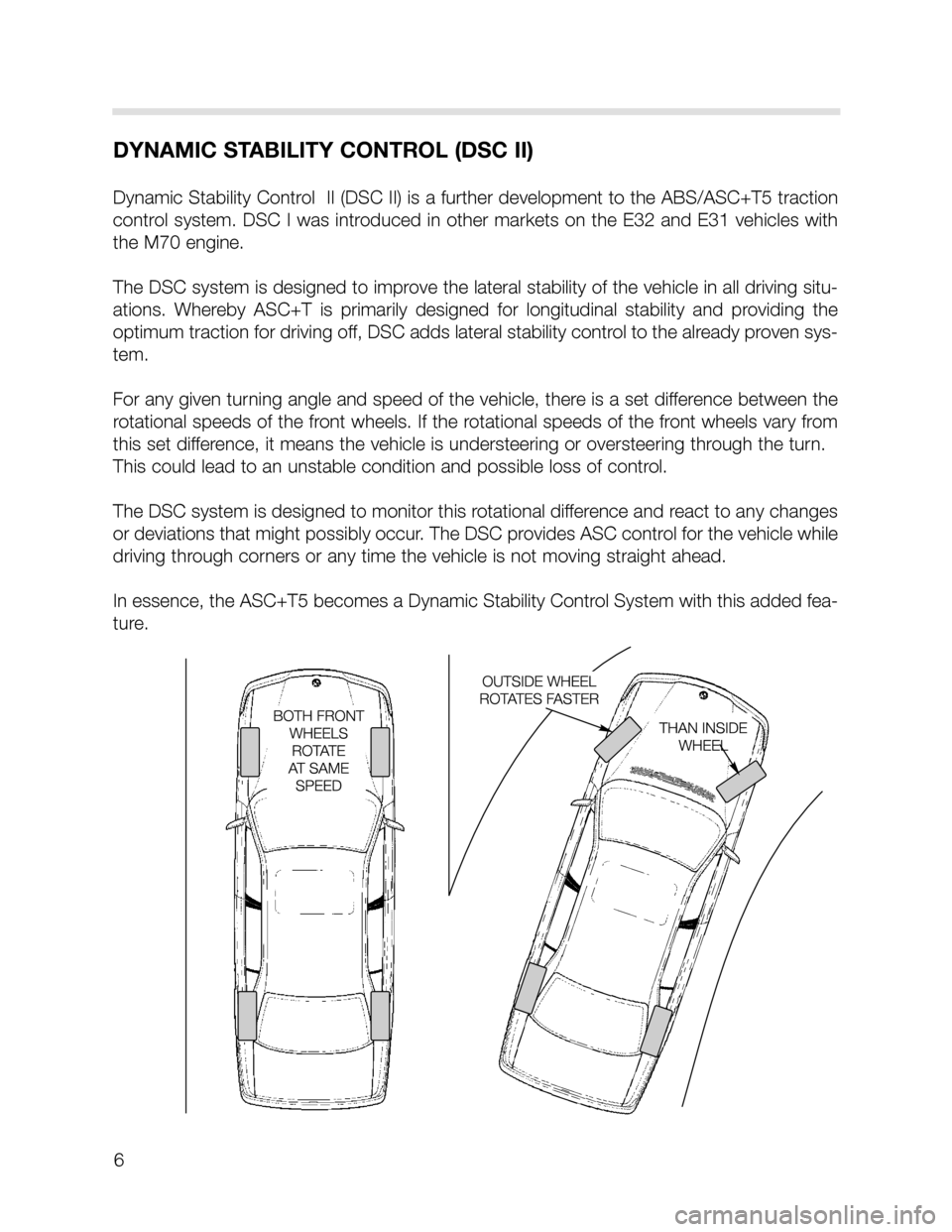
6
DYNAMIC STABILITY CONTROL (DSC II)
Dynamic Stability Control II (DSC II) is a further development to the ABS/ASC+T5 traction
control system. DSC I was introduced in other markets on the E32 and E31 vehicles with
the M70 engine.
The DSC system is designed to improve the lateral stability of the vehicle in all driving situ-
ations. Whereby ASC+T is primarily designed for longitudinal stability and providing the
optimum traction for driving off, DSC adds lateral stability control to the already proven sys-
tem.
For any given turning angle and speed of the vehicle, there is a set difference between the
rotational speeds of the front wheels. If the rotational speeds of the front wheels vary from
this set difference, it means the vehicle is understeering or oversteering through the turn.
This could lead to an unstable condition and possible loss of control.
The DSC system is designed to monitor this rotational difference and react to any changes
or deviations that might possibly occur. The DSC provides ASC control for the vehicle while
driving through corners or any time the vehicle is not moving straight ahead.
In essence, the ASC+T5 becomes a Dynamic Stability Control System with this added fea-
ture.
Page 7 of 24
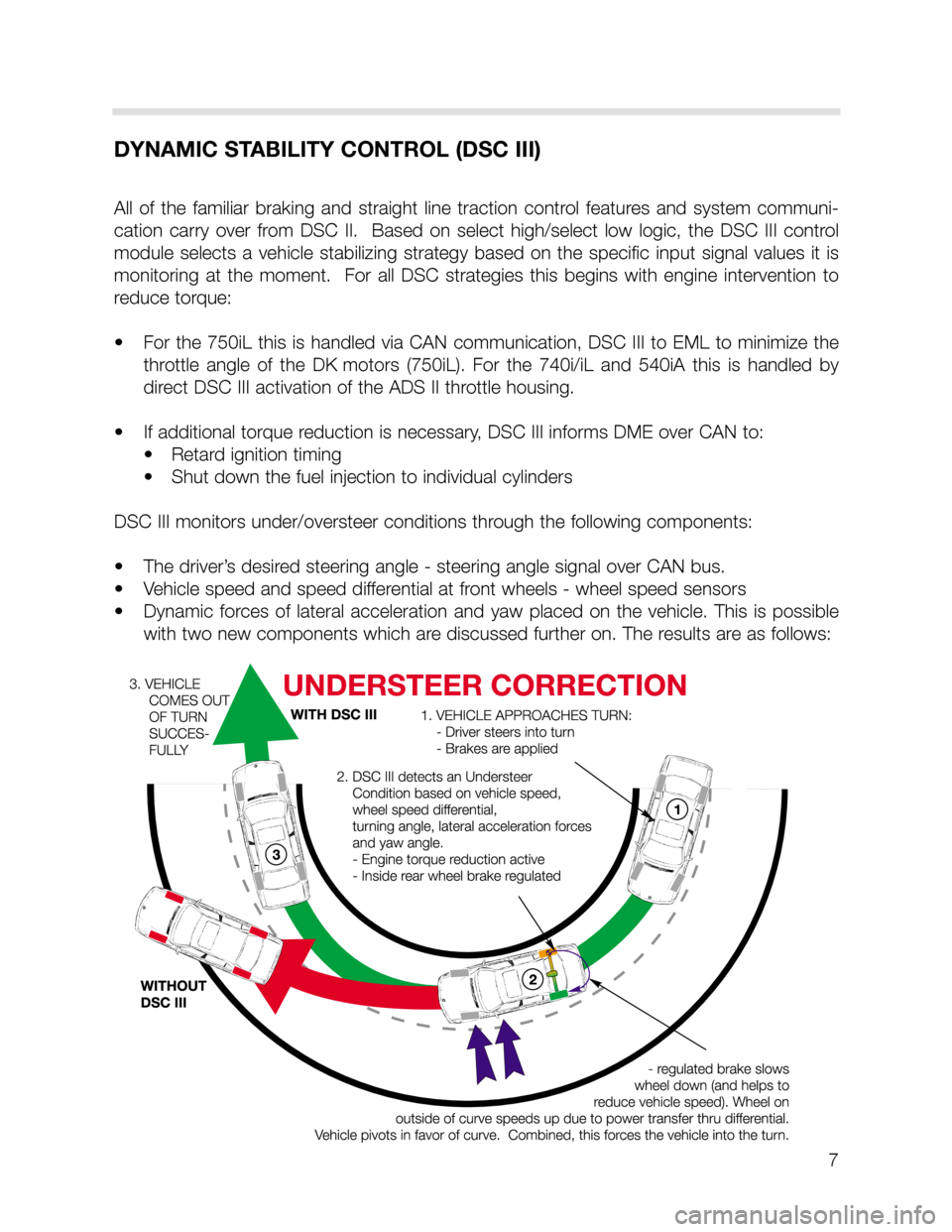
7
DYNAMIC STABILITY CONTROL (DSC III)
All of the familiar braking and straight line traction control features and system communi-
cation carry over from DSC II. Based on select high/select low logic, the DSC III control
module selects a vehicle stabilizing strategy based on the specific input signal values it is
monitoring at the moment. For all DSC strategies this begins with engine intervention to
reduce torque:
•For the 750iL this is handled via CAN communication, DSC III to EML to minimize the
throttle angle of the DK motors (750iL). For the 740i/iL and 540iA this is handled by
direct DSC III activation of the ADS II throttle housing.
• If additional torque reduction is necessary, DSC III informs DME over CAN to:
• Retard ignition timing
• Shut down the fuel injection to individual cylinders
DSC III monitors under/oversteer conditions through the following components:
• The driver’s desired steering angle - steering angle signal over CAN bus.
• Vehicle speed and speed differential at front wheels - wheel speed sensors
• Dynamic forces of lateral acceleration and yaw placed on the vehicle. This is possible
with two new components which are discussed further on. The results are as follows:
Page 15 of 24
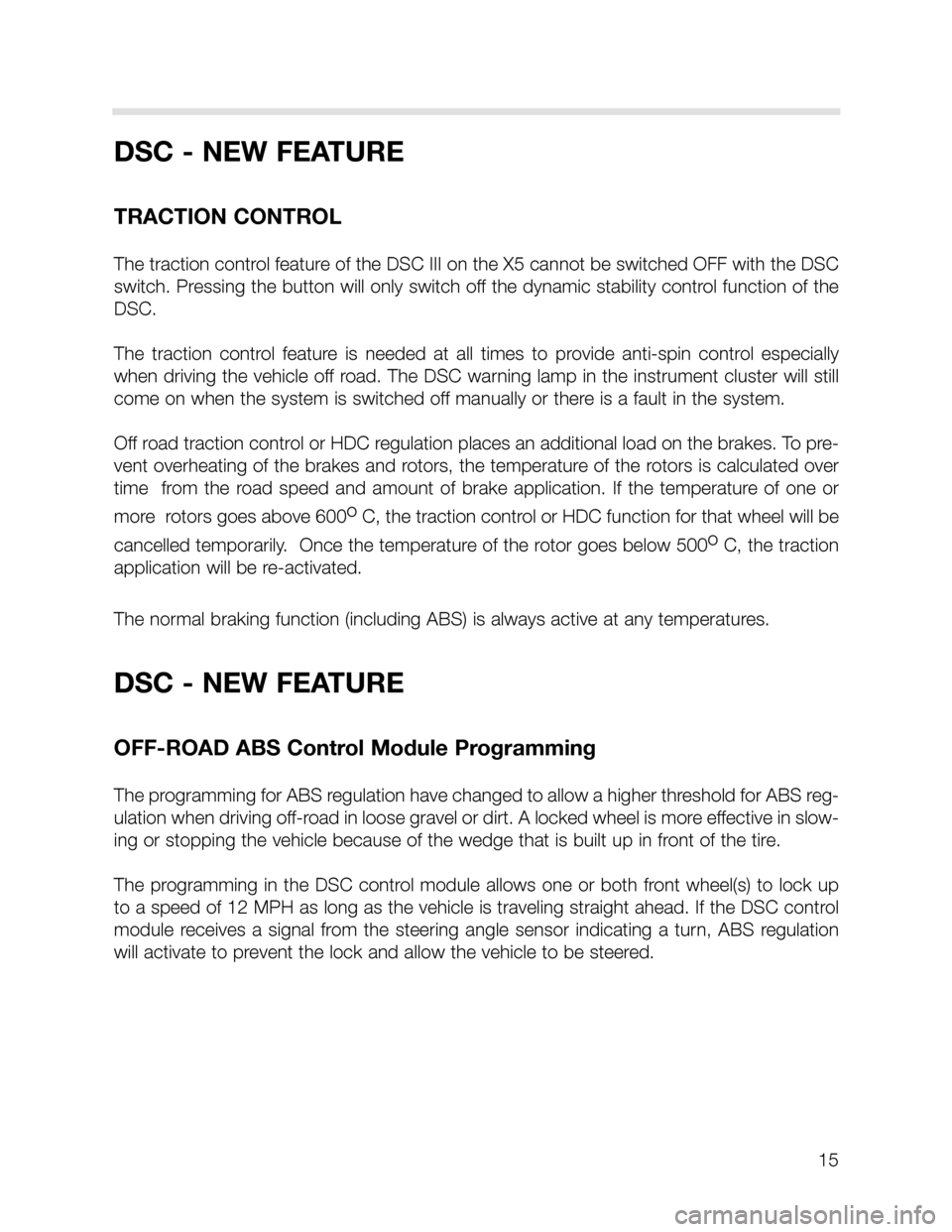
15
DSC - NEW FEATURE
TRACTION CONTROL
The traction control feature of the DSC III on the X5 cannot be switched OFF with the DSC
switch. Pressing the button will only switch off the dynamic stability control function of the
DSC.
The traction control feature is needed at all times to provide anti-spin control especially
when driving the vehicle off road. The DSC warning lamp in the instrument cluster will still
come on when the system is switched off manually or there is a fault in the system.
Off road traction control or HDC regulation places an additional load on the brakes. To pre-
vent overheating of the brakes and rotors, the temperature of the rotors is calculated over
time from the road speed and amount of brake application. If the temperature of one or
more rotors goes above 600o
C, the traction control or HDC function for that wheel will be
cancelled temporarily. Once the temperature of the rotor goes below 500o
C, the traction
application will be re-activated.
The normal braking function (including ABS) is always active at any temperatures.
DSC - NEW FEATURE
OFF-ROAD ABS Control Module Programming
The programming for ABS regulation have changed to allow a higher threshold for ABS reg-
ulation when driving off-road in loose gravel or dirt. A locked wheel is more effective in slow-
ing or stopping the vehicle because of the wedge that is built up in front of the tire.
The programming in the DSC control module allows one or both front wheel(s) to lock up
to a speed of 12 MPH as long as the vehicle is traveling straight ahead. If the DSC control
module receives a signal from the steering angle sensor indicating a turn, ABS regulation
will activate to prevent the lock and allow the vehicle to be steered.